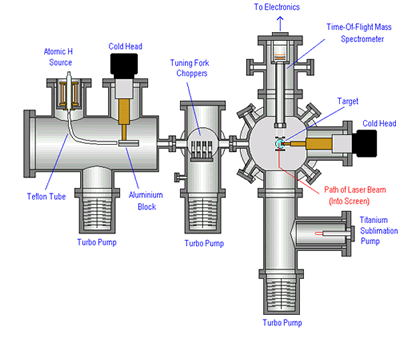|
| |
Cosmic Dust LabHydrogen Formation on Cosmic Dust AnaloguesThis experiment has now been running for some time and we are able to provide you with details of the experimental design and an update of recent results. This lab is now manned by Elspeth Latimer under the supervision of Prof Stephen Price but they acknowledge significant contribution from past members Dr Jon Gingell and Dr James Perry. Overview of experimental designThe Cosmic Dust Experiment was designed and built to investigate the molecular hydrogen formation process on surfaces. Its principal function is to irradiate cosmic dust analogues with H atoms under simulated ISM conditions. Any H2 molecules thus formed are laser-ionised, and H2+ ions detected by time-of-flight mass spectrometry. By tuning the energy of the laser photons the internal energy state of the H2 molecules to be ionised may be selected, thus allowing the rovibrational state distribution to be probed. The use of a tuneable laser to selectively photoionise the H2 product is unique to this experiment. Therefore, this apparatus will provide new results which could shed light on some of the unanswered questions in modern astrophysics. The Cosmic Dust Experimental apparatus in cross-section: Details of Component Parts
Experimental Progress (last update Nov 2001)Time-of-flight mass spectrometer has been calibrated and is able to detect H2+  Time-of-flight spectrum recorded through electron impact ionisation using an electron gun REMPI of H2 successfully carried out and laser fully calibrated.  REMPI spectrum for room temperature H2 in the ground (v" = 0) vibrational energy state. The first four rotational lines, corresponding to Q-branch transitions, can clearly be seen  Rotational populations for ground state (v" = 0) H2 gas at 295 K, power corrected and normalised to J = 0, in comparison with the expected Boltzmann distribution. First results taken from a cosmic dust target  REMPI signal of H2 molecules in the v" = 1, J" = 1 rovibrational state, that have formed on the surface of a diamond-like-carbon target at 200 K. This results implies that some of the binding energy released on the formation of the molecules on the target surface has gone into internal excitation of the product molecule as to thermally excited H2 into the v" = 1 vibrational state requires a temperature of ~ 9000 K. This page last modified 26 October, 2007 by John Edridge |
